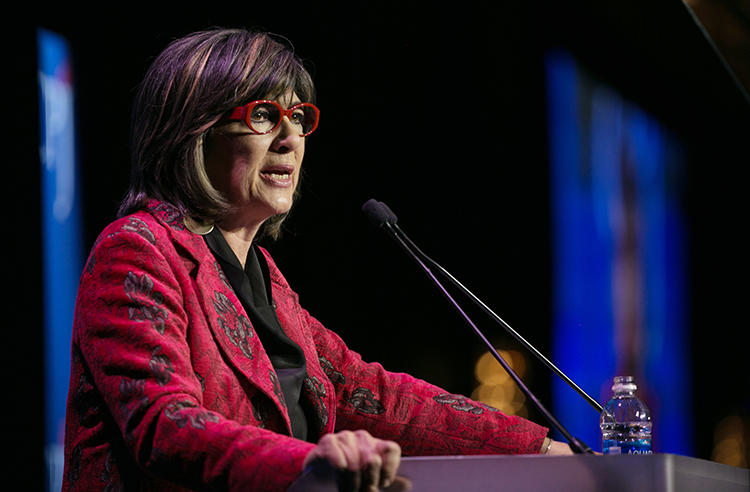By Christiane Amanpour/chief international correspondent for CNN and CPJ senior advisor
In November, I stood before top news media executives in the United States and called on them to stamp out sexual harassment in their organizations. “The floodgates are open,” I told the audience at the annual International Press Freedom Awards gala of the Committee to Protect Journalists (CPJ). Within days, the chair of that dinner, CBS News President David Rhodes, would fire the network’s morning show co-host Charlie Rose amid reports of sexual misconduct. Since then, the trickle of resignations has turned into a flood. Stories broke about other prominent journalists’ inappropriate behavior, and a second giant of morning network television, Matt Lauer of NBC, was soon swept away by the same tide.
We have a long way to go in our industry and in the wider society. Recently, we marked the one-year anniversary of the inauguration of a president who has bragged about sexual assault and has been accused of forcibly kissing a journalist from People magazine.
By speaking out, by raising our voices, we’ve exposed the abusers, and we applaud the industry leaders who’ve acted swiftly and decisively. But if we want to stamp out sexual harassment, we will need to make broader changes.
As a board member of CPJ and UNESCO’s Goodwill Ambassador for Freedom of Expression and Journalist Safety, I often meet journalists, both men and women, who stand up to power and pay a terrible price. I’m awed by the courage of all of them. But female reporters face special risks. Trolls stalk female reporters more than men. A study by British think tank Demos found that female journalists and TV news presenters receive roughly three times more abuse on Twitter than their male counterparts.
Character assassination, vicious personal attacks, doxing, and even death threats by regimes, religious fanatics, criminals, or militias are the cost of doing business for too many women in the media around the world. Take Khadija Ismayilova, a courageous investigative reporter from Azerbaijan. Authorities there tried to shame her by making public an intimate video tape. She was eventually imprisoned for 18 months.
Female reporters confront terrible risks in the field. Then they come home and face harassment and even assault in the workplace. Who knew that such dangers lurked in the newsrooms of liberal Western democracies? Well, many women reporters did. Some complained to employers. Some learned to navigate these toxic waters.
The dogged reporting of a handful of news organizations shattered the wall of silence around producer Harvey Weinstein, and the public outrage was palpable. He turned out to be just the tip of our own iceberg in the entertainment business. In the news industry we had the iceberg–Fox’s Roger Ailes and Bill O’Reilly.
These and other revelations seem to have encouraged more women to come forward. We need more. I want media owners, news executives, and editors to ruthlessly eliminate sexual harassment and banish predators from their organizations.
It is important that powerful serial harassers are taken down. But these were not the only men responsible: There were executives who made calculations of money or convenience, HR departments that were unresponsive or untrusting, lawyers who drafted non-disclosure agreements to keep women silent. We need to widen the lens and recognize that this is not a problem of a few bad apples.
The problem of sexual harassment and its pervasiveness in our industry is not just anecdotal.
A joint study by the International Women’s Media Foundation, where I serve as honorary board member, and the International News Safety Institute found that the most commonly reported perpetrators of “intimidation, threats, and abuse” were bosses.
When asked where they encountered physical violence, nearly half of the female reporters questioned said: “in the field.” But a startling 18 percent said: “in the office.”
The study, Violence and Harassment against Women in the News Media: A Global Picture, showed that nearly half of those surveyed had experienced sexual harassment, mostly in the office.
It’s disappointing that when the Columbia Journalism Review sent out a survey about sexual harassment policies to senior management in 149 newsrooms, it did not hear back from a single one in the first three weeks. Individual journalists, however, did respond to a separate survey. Hundreds of them. Eighty percent of freelancers said that if they wanted to report an instance of sexual harassment, they would not know how to do that.
We need a loud and proud declaration of zero tolerance. And there is one thing I know for sure: Women and young men will not feel safe until all our male colleagues and bosses are on our side.
It is ironic that the executives and editors who insist that reporters have safety training, flak jackets, and helmets when they send us to hot spots overseas often leave us to fend for ourselves at home.
Thanks to some brave women and some great reporting, the problem of pervasive sexual harassment has been exposed. There’s no closing our eyes. There’s no turning away. There’s no more tolerance. There’s no acceptance. This must end. It must end now.
Christiane Amanpour is CNN’s chief international correspondent and anchor of the network’s award-winning, flagship global affairs program “Amanpour.” She joined CPJ’s board of directors in 2005 and later began serving the organization as a senior advisor.
[EDITOR’S NOTE: This article first appeared in Columbia Journalism Review’s “Winter 2018 Issue,” published in partnership with CPJ.]
